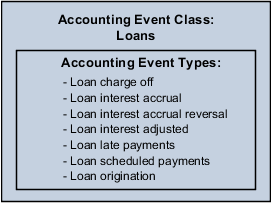Accounting Event Model
Accounting events represent transactions that may have financial significance, for example, issuing a loan and disposing of an asset. Financial accounting information can be recorded for these events and accounted by the Create Accounting process.
When you define accounting events, determine from a business perspective which activities or transactions that occur in your source system may create a financial impact.
-
Events with significantly different fiscal or operational implications are classified into different accounting event types.
-
Event types are categorized into accounting event classes.
-
Accounting definitions in Accounting Hub are based on event class and event types.
-
An event type must be unique within an application.
.
This figure illustrates an accounting event model for a loan application.

Event Class
An event class groups the related transaction information and attributes within a source system.
The event class is created using the registered source system name. For example, the Loans source system.
Event Types
When registering a source system, you can specify the event types as the transaction types of the source system.
For example, the event types Loan Origination and Loan Scheduled Payments are the types of transactions that have differences in their functional and operational implications.
User Transaction Identifiers
User transaction identifiers constitute the user-oriented key of the underlying subledger transaction.
These identifiers are primarily used in accounting events inquiry and on accounting event reports, to uniquely identify transactions.
-
When you register the source system using the spreadsheet template, use the Journal Display column to identify sources that are the user transaction identifiers.
-
You can specify up to ten columns from the transaction sources that are available for inquiry and reports.
The transaction data that identifies the transaction varies by subledger application.
Accounting event reports and inquiries display the transaction identifiers and their labels appropriate for the corresponding event class.
The user transaction identifiers can be displayed for an event regardless of its status. This includes the case when the accounting event hasn't been processed.
The user transaction identifier values are displayed at the time the accounting event reports and inquiries are run.